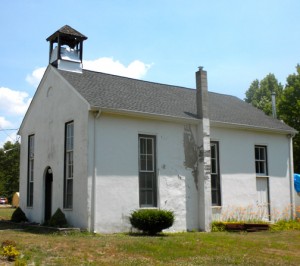By the late eighteenth century Methodists of African descent regularly faced discrimination and racism from white worshippers, prompting a widespread desire among blacks for religious autonomy. Unwilling to stop practicing their faith, many African Americans followed Richard Allen and Absalom Jones in their quest to form a new denomination: the African Methodist Episcopal (AME) Church. Denominational development was generally restricted to the Northeast and Midwest during the antebellum period; as the Civil War engulfed the nation, however, the AME Church’s influence quickly spread throughout all parts of the Union.
As members of the Boling Settlement grew increasingly weary of traveling far distances to attend church services, in June 1863 they began construction of their own house of worship, the Ebenezer African Methodist Episcopal Church. Two parcels of land were utilized, one located at the intersection of Mays Landing and Moss Mill Roads (present: Riverside Drive and Moss Mill Road intersection), and a second, smaller lot, adjacent to the north of the first property and on the south side of Riverside Drive. Total size of the church property was .64 acres.
When services at the Ebenezer AME Church began, there were approximately eight regular church members and five probationers. But after five members of the Boling Settlement enlisted to serve in the Union army the following year, church attendance remained limited until the war’s end. Prospects for the small Port Republic church subsequently picked up in the following years, especially after being inducted into various church circuits in the south Jersey area in the 1870s. Some of the earliest leaders of the Ebenezer AME Church included Pastor John Lukins, who served until his death in 1869; the Reverend Walter Thompson, who began preaching in 1873; and A. H. Brown, who joined in 1874.
Although no records in existence indicate when services at the Ebenezer AME Church ended, it is possible to conclude that they stopped within the first two decades of the twentieth century. The building itself seems to have been demolished sometime between 1914, the year in which Charles Boling died and was buried in the church’s cemetery, and 1931, when aerial photographs revealed no remaining buildings within the Boling Settlement.
Underground Railroad
The Underground Railroad acted as an important outlet for runaway slaves to the Northern states. Considering its many routes and secretive nature, it is impossible to ascertain a complete account of its history, but it is has been suggested that the Bolings and the Trustys were important figures in the Underground Railroad in southern New Jersey as early as the 1830s.[1]
Joseph and Alexander Trusty, brothers, began their work in the Underground Railroad around 1830. Joseph, while still in his early twenties, would bring fugitive slaves across the Delaware Bay by boat. This coincided with his growing interest in religion, founding and acting as the first preacher for the Bethel A.M.E. Church in Springtown, NJ, which doubled as an Underground Railroad station. Upon his relocation to Atlantic County around 1840, he became “the key agent” for the Underground Railroad in that area. Joseph Trusty is the father of James Trusty, who married Margaret Boling, daughter of Henry and Grace Boling. Alexander Trusty is the father of Ann Eliza Trusty, who married Charles Boling, son of Henry and Grace.
The Bethel A.M.E. Church, Springtown, N.J., was founded by Joseph Trusty. Oral histories relate that this was one of the stations used by Harriet Tubman from 1849 until 1853.
It has been suggested that Henry and Grace Boling hid fugitive slaves in the Boling Settlement as they made their way to Tuckerton, north of the Mullica River. Prior to 1860, James and Margaret Trusty relocated their family to the Boling Settlement, possibly to aid in Underground Railroad operations. It has also been suggested that once old enough, Charles and Eli Boling also helped, leading runaway slaves through the upper leg of the Mullica Township route. Although it is difficult to know the exact role individuals played, evidence points to the Bolings and Trustys aiding innumerable slaves over the decades.
[1] Emma Marie Trusty, The Underground Railroad Ties that Bound Unveiled: a History of the Underground Railroad in Southern New Jersey from 1770 to 1861 (Amed Literary, 1999).

